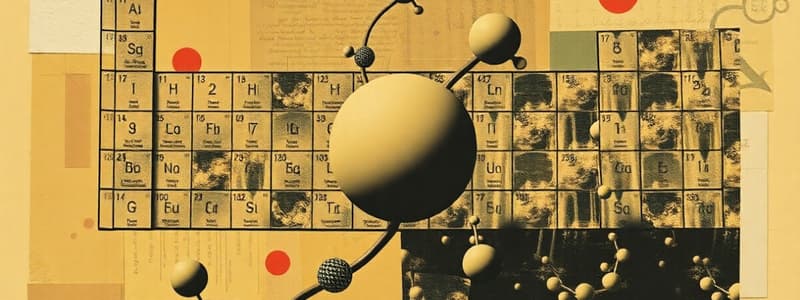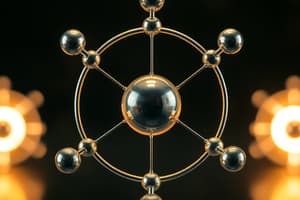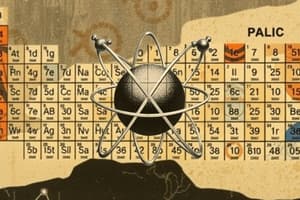Podcast
Questions and Answers
Which of the following properties is not characteristic of metals?
Which of the following properties is not characteristic of metals?
- Luster (shiny)
- Good conductors of heat and electricity
- Brittle and shatter when hit (correct)
- Malleable and ductile
What type of elements can both gain and lose electrons to form ions?
What type of elements can both gain and lose electrons to form ions?
- Metals (correct)
- Metalloids
- Nonmetals
- All of the above
Which sample is most likely to be a nonmetal based on its conductivity?
Which sample is most likely to be a nonmetal based on its conductivity?
- Sample B - Light bulb does not light (correct)
- Sample B - Malleable
- Sample A - Light bulb lights
- Sample C - Light bulb lights
In terms of physical properties, which statement is true about metalloids?
In terms of physical properties, which statement is true about metalloids?
What procedure would you use to test for malleability of a sample?
What procedure would you use to test for malleability of a sample?
What is a unique property of nonmetals compared to metals?
What is a unique property of nonmetals compared to metals?
Which of the following statements describes metals in terms of electron behavior?
Which of the following statements describes metals in terms of electron behavior?
Which statement most accurately describes the appearance of metals?
Which statement most accurately describes the appearance of metals?
What is the noble gas that comes before Aluminum (Al)?
What is the noble gas that comes before Aluminum (Al)?
What is the correct shorthand electron configuration for Strontium (Sr)?
What is the correct shorthand electron configuration for Strontium (Sr)?
Determine the correct noble gas configuration for tellurium (Te).
Determine the correct noble gas configuration for tellurium (Te).
What should the sum of the superscripts equal to for an element with atomic number 20?
What should the sum of the superscripts equal to for an element with atomic number 20?
Which atom among the following has the greatest shielding effect?
Which atom among the following has the greatest shielding effect?
What is the electron configuration for Zinc (Zn)?
What is the electron configuration for Zinc (Zn)?
What is the effective nuclear charge (Z_eff) for Al?
What is the effective nuclear charge (Z_eff) for Al?
If the size of an atom increases, which statement is true about its ionization energy?
If the size of an atom increases, which statement is true about its ionization energy?
Which noble gas is used in the configuration of Arsenic (As)?
Which noble gas is used in the configuration of Arsenic (As)?
Which atom will have a stronger hold on its electrons?
Which atom will have a stronger hold on its electrons?
Identify the electron orbital notation for Gallium (Ga).
Identify the electron orbital notation for Gallium (Ga).
What is the noble gas configuration for Mercury (Hg)?
What is the noble gas configuration for Mercury (Hg)?
In the alkali metal group, which of the following statements is true regarding atomic radius?
In the alkali metal group, which of the following statements is true regarding atomic radius?
Which of the following correctly describes electronegativity trends across a period?
Which of the following correctly describes electronegativity trends across a period?
If an atom has greater electron affinity, what can be inferred about its behavior?
If an atom has greater electron affinity, what can be inferred about its behavior?
What would be expected if the atomic radius decreases?
What would be expected if the atomic radius decreases?
What is the electron configuration for Sodium?
What is the electron configuration for Sodium?
Which rule states that no two electrons will have the same spin?
Which rule states that no two electrons will have the same spin?
What is the valence shell for Bromine?
What is the valence shell for Bromine?
Which group of elements in the periodic table is characterized as reactive nonmetals?
Which group of elements in the periodic table is characterized as reactive nonmetals?
What is the noble gas configuration for Oxygen?
What is the noble gas configuration for Oxygen?
What does the Aufbau Principle state regarding electron configurations?
What does the Aufbau Principle state regarding electron configurations?
Which of the following best describes alkali metals?
Which of the following best describes alkali metals?
Why does strontium have a larger atomic radius compared to magnesium?
Why does strontium have a larger atomic radius compared to magnesium?
How many valence electrons does Calcium (atomic # 20) have?
How many valence electrons does Calcium (atomic # 20) have?
Which of the following describes the characteristics of nonmetals?
Which of the following describes the characteristics of nonmetals?
Which rule explains that no two electrons in the same orbital can have the same spin?
Which rule explains that no two electrons in the same orbital can have the same spin?
What is the correct electron configuration for Arsenic (atomic # 33)?
What is the correct electron configuration for Arsenic (atomic # 33)?
What is the significance of having 8 valence electrons in an atom?
What is the significance of having 8 valence electrons in an atom?
According to Hund's Rule, what must occur within a set of orbitals?
According to Hund's Rule, what must occur within a set of orbitals?
How many total electrons does Magnesium (Mg) have based on its configuration 1s22s22p63s2?
How many total electrons does Magnesium (Mg) have based on its configuration 1s22s22p63s2?
In noble gas notation, which noble gas is used as the starting point for Argon (atomic # 18)?
In noble gas notation, which noble gas is used as the starting point for Argon (atomic # 18)?
What is the valence shell for Boron (atomic # 5)?
What is the valence shell for Boron (atomic # 5)?
Why does calcium have a larger atomic radius than bromine?
Why does calcium have a larger atomic radius than bromine?
What explains the larger size of the sulfide anion compared to the sulfur atom?
What explains the larger size of the sulfide anion compared to the sulfur atom?
Why is the potassium cation smaller than the potassium atom?
Why is the potassium cation smaller than the potassium atom?
What trend does ionization energy follow in the periodic table?
What trend does ionization energy follow in the periodic table?
Why does strontium have a smaller ionization energy compared to magnesium?
Why does strontium have a smaller ionization energy compared to magnesium?
What contributes to bromine having a larger ionization energy than calcium?
What contributes to bromine having a larger ionization energy than calcium?
Which element in Group IIIA (3A) has the largest atomic radius?
Which element in Group IIIA (3A) has the largest atomic radius?
Which scientist is credited with arranging elements by atomic number?
Which scientist is credited with arranging elements by atomic number?
Flashcards
Aufbau Principle
Aufbau Principle
Fill lower energy electron orbitals first when writing electron configurations.
Pauli Exclusion Principle
Pauli Exclusion Principle
Each electron has unique spin. Only two electrons can occupy one orbital, and they must have opposite spins.
Hund's Rule
Hund's Rule
Each orbital in a sublevel gets one electron before any gets two.
Electron Configuration
Electron Configuration
Signup and view all the flashcards
Valence Shell
Valence Shell
Signup and view all the flashcards
Valence Electrons
Valence Electrons
Signup and view all the flashcards
Electron Orbital
Electron Orbital
Signup and view all the flashcards
Noble Gas Notation
Noble Gas Notation
Signup and view all the flashcards
Atomic Number
Atomic Number
Signup and view all the flashcards
Sublevel
Sublevel
Signup and view all the flashcards
Noble Gas Configuration
Noble Gas Configuration
Signup and view all the flashcards
Shorthand Electron Configuration
Shorthand Electron Configuration
Signup and view all the flashcards
Aluminum's Noble Gas Configuration
Aluminum's Noble Gas Configuration
Signup and view all the flashcards
Arsenic's Noble Gas Configuration
Arsenic's Noble Gas Configuration
Signup and view all the flashcards
Calcium's Noble Gas Configuration
Calcium's Noble Gas Configuration
Signup and view all the flashcards
Phosphorus's Noble Gas Configuration
Phosphorus's Noble Gas Configuration
Signup and view all the flashcards
Zinc's Noble Gas Configuration
Zinc's Noble Gas Configuration
Signup and view all the flashcards
Metal Conductivity
Metal Conductivity
Signup and view all the flashcards
Metalloid Properties
Metalloid Properties
Signup and view all the flashcards
Nonmetal Conductivity
Nonmetal Conductivity
Signup and view all the flashcards
Metal Luster
Metal Luster
Signup and view all the flashcards
Metal State
Metal State
Signup and view all the flashcards
Metal Ductility
Metal Ductility
Signup and view all the flashcards
Metal Malleability
Metal Malleability
Signup and view all the flashcards
Nonmetal Brittleness
Nonmetal Brittleness
Signup and view all the flashcards
Shielding Effect
Shielding Effect
Signup and view all the flashcards
Effective Nuclear Charge (Zeff)
Effective Nuclear Charge (Zeff)
Signup and view all the flashcards
What happens to Zeff as you move down a group?
What happens to Zeff as you move down a group?
Signup and view all the flashcards
Atomic Radius
Atomic Radius
Signup and view all the flashcards
Ionization Energy
Ionization Energy
Signup and view all the flashcards
Electronegativity
Electronegativity
Signup and view all the flashcards
Electron Affinity
Electron Affinity
Signup and view all the flashcards
Trends - Atomic Radius & Ionization Energy
Trends - Atomic Radius & Ionization Energy
Signup and view all the flashcards
What is the Aufbau principle?
What is the Aufbau principle?
Signup and view all the flashcards
What is Hund's rule?
What is Hund's rule?
Signup and view all the flashcards
What is Pauli's Exclusion Principle?
What is Pauli's Exclusion Principle?
Signup and view all the flashcards
Why does atomic radius increase down a group?
Why does atomic radius increase down a group?
Signup and view all the flashcards
Why does atomic radius decrease across a period?
Why does atomic radius decrease across a period?
Signup and view all the flashcards
What are alkali metals?
What are alkali metals?
Signup and view all the flashcards
What are halogens?
What are halogens?
Signup and view all the flashcards
What are noble gases?
What are noble gases?
Signup and view all the flashcards
Atomic Radius Trend
Atomic Radius Trend
Signup and view all the flashcards
Ionization Energy Trend
Ionization Energy Trend
Signup and view all the flashcards
Why is Calcium larger than Bromine?
Why is Calcium larger than Bromine?
Signup and view all the flashcards
Why is Sulfide larger than Sulfur?
Why is Sulfide larger than Sulfur?
Signup and view all the flashcards
Why is Potassium cation smaller than Potassium atom?
Why is Potassium cation smaller than Potassium atom?
Signup and view all the flashcards
Why does Strontium have a smaller ionization energy than Magnesium?
Why does Strontium have a smaller ionization energy than Magnesium?
Signup and view all the flashcards
Why does Bromine have a larger ionization energy than Calcium?
Why does Bromine have a larger ionization energy than Calcium?
Signup and view all the flashcards
Who developed the Periodic Table?
Who developed the Periodic Table?
Signup and view all the flashcards
Study Notes
Honors Unit 3: The Electron and Periodic Table
- The periodic table displays elements arranged by atomic number.
- Elements with similar properties are grouped together.
- Rows on the table are called periods.
- Columns on the table are called families or groups.
- Atomic Models evolved over time with discoveries like the electron and nucleus.
- Dalton's model, Thomson's model, Rutherford's model, Bohr Model, and the Quantum Mechanical model each expanded on previous understanding.
- Atoms contain a nucleus with protons and neutrons, and electrons orbit the nucleus.
- Electrons can gain or lose energy levels.
- Light has wave properties, including amplitude and frequency, and wavelength.
- Frequency and wavelength are inversely proportional. A shorter wavelength implies a higher frequency.
- Elements emit light of specific wavelengths when heated. This is due to electrons switching energy levels.
- The atomic emission spectrum is unique to each element.
- Atomic orbitals are regions of space where electrons are likely found.
- Orbitals have different shapes and orientations (s, p, d, f). Different orbitals hold various numbers of electrons.
- Electron configuration describes the arrangement of electrons in orbitals within an atom.
- Electron configuration follows the Aufbau Principle (filling lowest energy orbitals first), Hund's Rule (one electron in each orbital before doubling up), and Pauli Exclusion Principle (no two electrons have the same four quantum numbers).
- Each electron can be represented by a coefficient (energy level), letter (orbital), and superscript (number of electrons).
- Noble Gas notation is a shorthand representation of electron configuration.
- Periods represent energy levels and groups represent valence electron similarities.
- Periodic trends relate to properties like atomic radius, ionization energy, electronegativity, and electron affinity across the periodic table and within groups. These trends can be explained by changes in nuclear charge and shielding. An increase in nuclear charge results in a stronger attraction between the nucleus and electrons in an atom. Effective nuclear charge also affects the size of atoms.
- Cations are positively charged ions (loss of electrons) while anions are negatively charged ions (gaining of electrons).
- The size of ions differs from the size of parent atoms, depending on the gain or loss of electrons.
Studying That Suits You
Use AI to generate personalized quizzes and flashcards to suit your learning preferences.
Related Documents
Description
This quiz covers the fundamental concepts of the electron, atomic models, and the organization of the periodic table. Explore how atomic theory evolved through various models, the arrangement of elements by atomic number, and the properties of light associated with atomic emission. Test your understanding of these key principles in chemistry.




